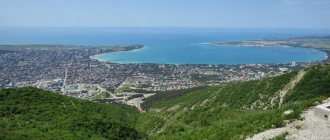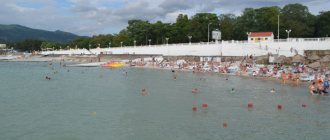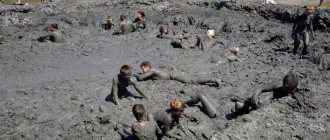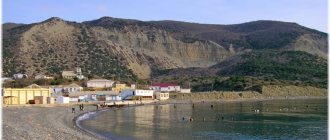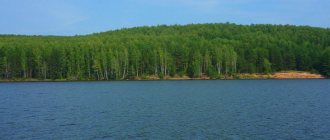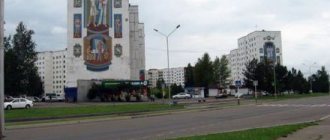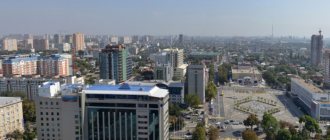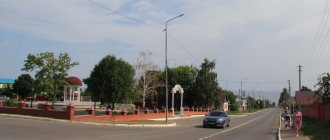Content
- 1 Largest cities 500 thousand - 1 million people 1.1 Vladivostok
- 2.1 Ussuriysk
- 3.1 Arsenyev
Largest cities 500 thousand - 1 million people
Coat of arms of Vladivostok
Vladivostok
Population 604,901 people (2018). Administrative center of Primorsky Krai.
Capital of the Far East (2018)
Founded in 1860, city since 1880. It is a major seaport and naval base, as well as the terminus of the Trans-Siberian Railway. Scientific and educational center. Shipbuilding and ship repair center - among other things, the city is home to the Vostochnaya Shipyard and.
The city is home to the Russian Bridge, the largest cable-stayed bridge in the world in terms of the width of the main span, as well as the structures of the Vladivostok Fortress, one of the strongest fortresses in the world at the beginning of the 20th century.
It has the status of a city of military glory.
General information about Primorsky Krai
Distinctive features .
The Primorsky Territory has a number of features that make it worth coming here at least once in your life. Maybe not forever, maybe for a week, for a month. But it’s definitely worth getting to know this unique region and its beauties. The first feature is nature. On one side is the taiga, where real wild tigers and bears, deer and squirrels live. On the other side is the blue sea, rich in its gifts.
And all this can be seen in Primorye at the same time! The generous Far Eastern nature offers simple but pleasant entertainment - picking mushrooms, berries and nuts in the local forests. And for seafood lovers, a real paradise awaits here: huge Far Eastern crabs, sea cucumbers, mussels, scallops, shrimp, sea urchins, octopuses, seaweed... Even in Soviet times, when there was a general shortage of food, residents of Vladivostok and Primorye could catch any kind of food for dinner seafood delicacies, whatever they want.
This is not manna from heaven. These are mollusks that the next typhoon brought to the residents of Vladivostok. Photo by Svetlana Laletina
The second feature is the port city of Vladivostok and its surroundings, where the naval base of the Russian Navy is located. Glorious military traditions are loved and honored here. This is one of the few Russian cities where on the last Sunday of August a naval parade takes place, or it would be more correct to call it a naval show. If you walk around Vladivostok, you will find many monuments related to the fleet and its history.
The third feature is the unique geographical location, which has not only disadvantages, but also its advantages. Despite the fact that there are 9,177 km from Vladivostok to Moscow, only 205 km separates Vladivostok from the border with China. This is very convenient for both tourism and business. It’s also a stone’s throw from here to Japan, and the countries of Southeast Asia are not that far away, where getting from Primorye is much faster than from the Russian capital. By the way, even if you don’t take into account the time gain, tours from Vladivostok to Thailand are 20-25% cheaper than from Moscow.
Geographical location . Primorsky Krai is located on the southeastern tip of Russia, in the southern part of the Far Eastern Federal District. From the south and east, its lands are washed by the Sea of Japan. In the north it borders with the Khabarovsk Territory, in the west with the People's Republic of China. The relief is mountainous, a significant part of the territory is occupied by the Sikhote-Alin ridge.
Pines and sea - a typical seaside landscape
There are beautiful lakes, caves and waterfalls in the mountains. The largest lake is Khanka, on the border with China. The main river of Primorye is the Ussuri.
The unique nature of the Primorsky Territory with rare flora and fauna requires protection from poachers and other vandals. Now in Primorye there are 6 nature reserves, 3 national parks and one nature park. Here they are trying to preserve such endangered species as the Amur tiger and the Far Eastern leopard.
The Amur tiger is the master of the taiga
Population. Even during the times of the Russian Empire, Primorye was settled voluntarily and forcibly. Cossacks were sent here to protect our borders, peasants instead of serving, convicts to serve their sentences. Also, free land was allocated to all willing settlers. Under the Union, the Primorsky Territory began to be populated even faster. Up until 1989, there was a steady increase in both urban and rural populations. And then Primorye began to have serious economic problems, and the population began to decrease at the same rate as it had previously grown. Currently, 1,947,263 people live in the Primorsky Territory, which approximately corresponds to the level of 1980.
Emerald Valley - a man-made landscape paradise near Ussuriysk
The majority of Russians live in the Primorsky Territory (85.66%). In second place are Ukrainians (2.55%), in third are Koreans (0.96%). In fact, much more Ukrainians live here, and they began to come here en masse at the end of the 19th century, when regular sea communications were established between Odessa and Vladivostok. And now there are different realities: in Primorye there are many visitors from Central Asia and the Caucasus who, it seems, have no intention of returning home. More recently, another headache has been added: illegal immigrants from China, Vietnam and other Asian countries are entering Vladivostok by all possible means.
Crime . 11th place in the criminal ranking of regions is a very sad indicator, indicating that the crime level in Primorye is quite high. Despite the fact that Primorye is located in the south of the country, the population here is no less harsh than in the Russian North. Wild forests, the Ussuri taiga, remoteness from Moscow - all this leaves an imprint on local morals. An important factor in the high crime rate is the difficult economic situation in Primorye. In addition, Vladivostok also has its own specifics - a seaport, cargo transshipment, customs - fertile ground for the development of organized crime.
The unemployment rate in Primorye is very high at 6.87%. But local residents have a way to escape. For example, a common business for locals is driving cheap used Japanese cars to the western regions of Russia, where they charge completely different prices for them. The state is looking for different ways to increase business activity in the region, but so far the situation is far from ideal.
If we talk about official income, the average salary in Primorye is 27,365 rubles. The highest salaries are in the production of petroleum products (51.6 thousand rubles), in the financial sector (50.6 thousand rubles), in science (38 thousand rubles) and transport (35 thousand rubles).
Property value. The average cost of a one-room apartment on the secondary market is from 1.7 million rubles. New one-room apartments are sold for 2.5 million rubles and more. The price for two-room apartments is already much higher, and starts somewhere from 2.5 million rubles for old housing stock and 3.5 million rubles for new buildings.
Climate. The Primorsky Territory has its own Far Eastern weather, and it is unlikely to seem familiar to a resident of the European plains. This climate is classified as moderate monsoon. In summer, there are typhoons coming from the south, bringing fog, heavy rain and floods. Of course, farming in such conditions is hellish work. In the hottest summer months, the average temperature is +17…+26°C. In winter, the opposite is true. Cold northern winds bring dry frosty air. Although the average temperature in January is −15°C, the sea subjectively feels even colder. And in the depths of the continent, even the thermometer will clearly show −20° and below. As already mentioned, the region is very rainy and the average annual precipitation is 600-900 mm per year. True, most of them fall in the warm season.
Large cities 100-250 thousand people
Coat of arms of Ussuriysk
Ussuriysk
Population 168,598 (2016). Founded in 1866, city since 1898. It is located at the junction of the Trans-Siberian Railway, a branch towards the border with China in the direction of the former Chinese Eastern Railway. Previously called Nikolsk, Nikolsk-Ussuriysky and Voroshilov. Food Industry Center.
Coat of arms of Nakhodka
Nakhodka
Population 153,581 (2016). Founded in 1864, city since 1950. The largest transport hub - in the city, among other things, there are two large seaports - Nakhodka and Vostochny. Center for fishing and fish processing industry.
Coat of arms of Artyom
Artyom (city)
Population 105,338 (2016). A large transport hub in which the Vladivostok international airport is located.
Districts on the map of Primorsky Krai
Primorye is divided into 22 districts, 4 of which are included in the Far North zone:
- Terneysky;
- Dalnegorsky;
- Olginsky;
- Kavalerovsky.
These areas on the map of Primorsky Krai are characterized by the least developed infrastructure, a small number of settlements and difficult living conditions. There are almost no economic facilities or industrial enterprises here, and trade is poorly developed.
There are numerous hunting grounds in the region. In Chuguevskaya and Terneysky there is hunting for wapiti and elk, and in Lazovsky and Pozharsky there are wild boars and bears. On a detailed map of the Primorsky Territory you can find suitable places for active recreation, hunting and ecotourism. Also in the region is Lake Elma with a large supply of mineral springs and healing mud.
The largest districts in Primorye:
- Spassky;
- Krasnoarmeysky;
- Terneysky.
The railway runs along the western border of the region. From here the Trans-Siberian railway runs to Moscow. In the northern regions, transport links are poorly developed. A detailed road map of the Primorsky Territory shows that the main highways pass through the southern and western regions.
Near Vladivostok there is the Knevichi International Airport. There are also several major ports in the region, whose main activities are related to fishing and container cargo transportation.
Medium-sized cities 20-100 thousand people
Arsenyev
Population 52,471 (2018).
Spassk-Dalniy
Population 40,717 people (2018).
Big Stone
Population 38,042 people (2018). The city is home to Dalnevostochny, which in the short term will be the largest shipbuilding enterprise in the country.
Partizansk
Population 37,470 people (2016).
Lesozavodsk
Population 37,059 (2018).
Dalnegorsk
Population 34,694 people (2018).
Dalnerechensk
Population 25,786 people (2018).
Fokino (Primorsky Krai)
There are other settlements and objects with this name, see Fokino
Population 23,077 people (2018). It should not be confused with the city of the same name in the Bryansk region. Closed city of the Pacific Fleet.
Economy of the city of Nakhodka
Main industrial enterprises: Primorsky Shipping Company, OJSC Gaydamak Ship Repair Plant. Marine fishing base (JSC Yuzhmorybflot, JSC Nakhodka Base of Active Marine Fisheries, LLC DV Rybnaya). Tin and can factory. Production of reinforced concrete products for large-panel housing construction. Nakhodka is a port of international importance, a center of coastal trade. Export of timber, coal, fluorspar, honey, fish, fish and seafood products. The Vostochny port is located near Nakhodka. Nakhodka is a free economic zone.
Nakhodka Bay
see also
- Primorsky Krai
- Cities of Russia
| [ + ] Cities by regions of Russia | |
| Cities of the North-West (NWFD) | St. Petersburg (and its cities) • Leningrad region (historical Staraya Ladoga) • Arkhangelsk region • Vologda region • Kaliningrad region • Karelia • Komi • Murmansk region • Nenets Autonomous Okrug • Pskov region |
| Cities of the Volga region (Volga Federal District) | Bashkortostan • Volgograd region • Kalmykia • Kirov region • Mari El • Mordovia • Nizhny Novgorod region • Orenburg region • Penza region • Perm region • Samara region • Saratov region • Tatarstan • Udmurtia • Ulyanovsk region • Chuvashia |
| Cities of Southern Russia (SFD) | Sevastopol (including Inkerman) • Republic of Crimea • Adygea • Astrakhan region • Krasnodar region • Rostov region |
| Cities of the North Caucasus (NCFD) | Dagestan • Ingushetia • Kabardino-Balkaria • Karachay-Cherkessia • North Ossetia - Alania • Stavropol Territory • Chechen Republic |
| Cities of the Urals (Ural Federal District) | Kurgan region • Sverdlovsk region • Tyumen region • Khanty-Mansi Autonomous Okrug - Yugra • Chelyabinsk region • Yamalo-Nenets Autonomous Okrug |
| Cities of Siberia (Siberian Federal District) | Altai Republic • Altai Territory • Irkutsk Region • Kemerovo Region • Krasnoyarsk Region • Novgorod Region • Novosibirsk Region • Omsk Region • Tomsk Region • Tyva • Khakassia |
| Cities of the Far East (FEFD) | Amur Region • Buryatia • Jewish Autonomous Region • Trans-Baikal Territory • Kamchatka Territory • Magadan Region • Primorsky Territory • Sakha (Yakutia) • Sakhalin Region • Khabarovsk Territory • Chukotka Autonomous Region |
| see also | Cities of the DPR, LPR, Transnistria, South Ossetia • Regions of Russia • Cities of Russia |
CITIES OF PRIMORSKY REGION
Primorsky Territory total population - 2022.5 men - 970.3 women - 1049.2 Vladivostok1) total population - 610.2 men - 285.4 women - 324.8 Artem 1) total population - 111.6 men - 52.7 women - 58.9 Nakhodka 1) total population - 172.7 men - 83.8 women - 88.9 Ussuriysk total population - 154.8 men - 74.6 women - 80.2 Population density (as of January 1, 2006), people per 1 km2: Primorsky Territory - 12.3 Vladivostok - 1086.7 Artem - 220.4 Nakhodka - 529.9 Ussuriysk - 895.3 |
Districts - 24 Cities - 12 Urban districts (districts) - 5 Urban settlements - 31 Rural administrations (including village councils, volosts, rural districts and local governments) - 226 Cities (number of inhabitants - estimate as of January 1, 2006, thousand people): Vladivostok - 583.7 Nakhodka - 171.7 Ussuriysk - 154.8 Artem - 102.3 Arsenyev - 59.7 Spassk-Dalniy - 46.9 Partizansk - 41.6 Lesozavodsk - 42.0 Dalnegorsk - 39.2 Bolshoi Kamen - 38.2 Dalnerechensk - 29.1 Fokino - 25.8 Territory area, thousand km2: Primorsky Krai - 164.7 Vladivostok 1) - 561.5 Artem 1) - 506.4 Nakhodka 1) - 325.9 Ussuriysk - 172.9 |
__________ 1) Including settlements subordinate to the city administration.
GROUPING CITIES BY PERMANENT POPULATION1)
| Total | including the number of inhabitants, thousand people | ||||||||||
| until 3 | 3 — 4,9 | 5 — 9,9 | 10 -19,9 | 20 — 49,9 | 50 — 99,9 | 100 — 249,9 | 250 — 499,9 | 500 — 999,9 | 1 million or more | ||
| Number of cities | |||||||||||
| 2005 | 12 | — | — | — | — | 7 | 1 | 3 | — | 1 | — |
| 2006 | 12 | — | — | — | — | 7 | 1 | 3 | — | 1 | — |
| Population, thousand people | |||||||||||
| 2005 | 1344,7 | — | — | — | — | 265,6 | 60,6 | 431,7 | — | 586,8 | — |
| 2006 | 1335,0 | — | — | — | — | 262,8 | 59,7 | 428,8 | — | 583,7 | — |
| __________ 1) Estimate as of January 1. | |||||||||||
DISTRIBUTION OF POPULATION OF VLADIVOSTOK AND CITIES WITH A POPULATION OVER 100 thousand people BY AGE GROUPS1) (thousand people)
| Vladivostok | Artem | Nakhodka | Ussuriysk | |||||
| 2005 | 2006 | 2005 | 2006 | 2005 | 2006 | 2005 | 2006 | |
| Whole population | 586,8 | 583,7 | 102,2 | 102,3 | 173,5 | 171,7 | 156,0 | 154,8 |
| including those aged: | ||||||||
| younger than able-bodied | 80,6 | 78,0 | 16,5 | 16,1 | 27,6 | 26,4 | 25,2 | 24,4 |
| of which children aged 1-6 years | 25,9 | 27,3 | 5,2 | 5,4 | 8,8 | 9,0 | 8,5 | 8,9 |
| able-bodied2) | 395,2 | 392,8 | 66,2 | 66,6 | 114,6 | 113,5 | 105,0 | 104,6 |
| older than able-bodied | 111,0 | 112,9 | 19,5 | 19,6 | 31,3 | 31,8 | 25,8 | 25,8 |
| __________ 1) Estimate as of January 1. 2) Men 16-59 years old, women 16-54 years old. | ||||||||
SHARE OF VLADIVOSTOK AND CITIES WITH A POPULATION OF OVER 100 thousand people IN THE MAIN SOCIO-ECONOMIC INDICATORS OF PRIMORSKY TERRITORY in 2005 (percent)
| Vladivostok1) | Artem1) | Nakhodka1) | Ussuriysk | |
| Population (est. January 1, 2006) | 30,2 | 5,5 | 8,6 | 7,7 |
| Average annual number of employees in organizations | 39,2 | 3,9 | 9,2 | 9,1 |
| Availability of fixed assets of organizations2) (at the end of the year) | 53,0 | 1,6 | 5,3 | 8,1 |
| Volume of shipped goods of own production, work and services performed in-house, by type of activity 3): | ||||
| mining | 2,1 | 2,8 | 0,2 | 0,1 |
| manufacturing industries | 33,4 | 2,8 | 12,1 | 14,7 |
| production and distribution of electricity, gas and water | 31,6 | 15,5 | 4,4 | 4,0 |
| Scope of work performed for the type of activity “Construction” | 44,6 | 4,3 | 14,5 | 14,1 |
| Commissioning of the total area of residential buildings | 50,3 | 7,8 | 12,2 | 11,6 |
| Retail trade turnover | 53,4 | 3,5 | 8,7 | 9,8 |
| Investments in fixed capital | 45,5 | 3,8 | 10,2 | 5,5 |
| __________ 1) Including settlements subordinate to the city administration. 2) At the full accounting value of large and medium-sized commercial and non-profit organizations. 3) For large and medium-sized organizations. | ||||
SOCIO-ECONOMIC CHARACTERISTICS OF VLADIVOSTOK AND CITIES WITH A POPULATION OF OVER 100 THOUSAND PEOPLE
| Vladivostok1) | Artem1) | Nakhodka1) | Ussuriysk | |||||
| 2004 | 2005 | 2004 | 2005 | 2004 | 2005 | 2004 | 2005 | |
| POPULATION | ||||||||
| Population (end of year estimate), thousand people | 613,4 | 610,2 | 111,5 | 111,6 | 174,6 | 172,7 | 156,0 | 154,8 |
| Number of births per 1000 population | 9,3 | 9,2 | 10,2 | 10,7 | 9,7 | 9,2 | 11,6 | 11,0 |
| Number of deaths per 1000 population | 13,4 | 13,0 | 18,9 | 19,0 | 14,0 | 14,6 | 16,9 | 17,5 |
| Natural increase, decrease (-) per 1000 population | -4,1 | -3,8 | -8,7 | -8,3 | -4,3 | -5,4 | -5,3 | -6,5 |
| WORK | ||||||||
| Average annual number of employees in organizations, thousand people | 272,6 | 254,7 | 27,4 | 25,6 | 63,7 | 59,6 | 63,5 | 58,9 |
| Number of unemployed citizens registered with the state employment service (at the end of the year), people | 4452 | 5158 | 1233 | 1063 | 1557 | 2069 | 14412) | 22122) |
| of them are recognized as unemployed | 3610 | 3824 | 1076 | 953 | 1393 | 1915 | 13622) | 14642) |
| LIVING STANDARD OF THE POPULATION AND SOCIAL SPHERE | ||||||||
| Average monthly nominal accrued wages, rub. | 7933,1 | 10267,0 | 6768,0 | 8446,4 | 8049,3 | 10070,3 | 6887,0 | 8571,7 |
| Average amount of assigned monthly pensions (at the end of the year), rub. | 2142,1 | 2721,9 | 2033,9 | 2523,5 | 2049,0 | 2542,7 | 2018,42) | 2510,02) |
| Number of pensioners (at the end of the year), thousand people | 138,4 | 139,7 | 28,2 | 28,2 | 38,3 | 38,7 | 42,12) | 42,32) |
| Total area of residential premises per average city resident (at the end of the year), m2 | 18,7 | 19,0 | 19,2 | 19,3 | 17,1 | 17,4 | 18,5 | 18,8 |
| Number of preschool institutions | 117 | 117 | 24 | 24 | 35 | 34 | 31 | 31 |
| in them: | ||||||||
| children, thousand people | 16,0 | 16,3 | 3,0 | 3,2 | 5,6 | 5,8 | 4,6 | 4,8 |
| places, thousand | 16,0 | 15,7 | 3,2 | 3,2 | 5,4 | 5,4 | 3,9 | 4,0 |
| Enrollment of children in preschool educational institutions (at the end of the year), as a percentage of the number of children of the corresponding age | 59,7 | 56,4 | 52,6 | 53,8 | 65,7 | 63,7 | 55,4 | 53,0 |
| Number of daytime educational institutions (at the beginning of the school year) | 115 | 117 | 28 | 28 | 39 | 38 | 30 | 29 |
| Number of students in daytime general education institutions, thousand people | 61,2 | 58,1 | 12,5 | 11,9 | 19,8 | 18,2 | 16,8 | 15,9 |
| Number of doctors, people: | ||||||||
| Total | 6147 | 6294 | 409 | 382 | 823 | 813 | 669 | 702 |
| per 10,000 population | 100,2 | 103,1 | 36,7 | 34,2 | 47,1 | 47,1 | 42,9 | 45,4 |
| Number of nursing staff, people: | ||||||||
| Total | 5786 | 5749 | 546 | 539 | 1444 | 1492 | 1672 | 1757 |
| per 10,000 population | 94,3 | 94,2 | 49,0 | 48,3 | 82,7 | 86,4 | 107,2 | 113,5 |
| Number of hospitals | 39 | 38 | 9 | 8 | 10 | 10 | 9 | 9 |
| Number of hospital beds: | ||||||||
| total, thousand | 8,2 | 8,1 | 0,6 | 0,6 | 1,5 | 1,5 | 1,8 | 1,8 |
| per 10,000 population | 133,7 | 133,5 | 53,6 | 53,6 | 88,4 | 87,7 | 114,4 | 113,7 |
| Number of medical outpatient clinics | 159 | 171 | 19 | 19 | 36 | 51 | 27 | 38 |
| Capacity of medical outpatient clinics, visits per shift: | ||||||||
| total, thousand | 13,8 | 14,3 | 1,9 | 1,9 | 4,0 | 4,4 | 2,9 | 3,4 |
| per 10,000 population | 225,1 | 233,7 | 167,6 | 167,3 | 231,3 | 257,6 | 186,6 | 216,8 |
| Number of registered crimes | 17083 | 23100 | 2457 | 3416 | 4144 | 5855 | 55872) | 61782) |
| Persons who committed crimes were identified, people | 5047 | 4811 | 1061 | 1049 | 1558 | 1557 | 18432) | 17952) |
| ENTERPRISES AND ORGANIZATIONS | ||||||||
| Number of enterprises and organizations (at the end of the year; according to state registration) | 33827 | 37089 | 1940 | 2035 | 5010 | 5399 | 2744 | 2925 |
| MINERAL MINING, MANUFACTURING, PRODUCTION AND DISTRIBUTION OF ELECTRICITY, GAS AND WATER3) | ||||||||
| Number of operating organizations by type of activity (at the end of the year): | ||||||||
| mining | … | 3 | … | 3 | … | 2 | … | 3 |
| manufacturing industries | … | 239 | … | 43 | … | 75 | … | 92 |
| production and distribution of electricity, gas and water | … | 52 | … | 7 | … | 27 | … | 26 |
| Volume of shipped goods of own production, work and services performed in-house, by type of activity, million rubles: | ||||||||
| mining | 126,3 | 133,9 | 153,6 | 180,4 | 13,4 | 11,8 | 2,7 | 4,1 |
| manufacturing industries | 8325,6 | 9514,5 | 695,3 | 791,7 | 2257,0 | 3444,6 | 3675,1 | 4189,1 |
| production and distribution of electricity, gas and water | 6468,9 | 8101,9 | 3054,9 | 3980,2 | 930,7 | 1127,6 | 515,2 | 1023,1 |
| CONSTRUCTION | ||||||||
| Amount of work performed by type of activity “Construction”, million rubles. | 5143,7 | 6271,0 | 475,1 | 606,4 | 1725,3 | 2038,4 | 1587,2 | 1982,8 |
| Commissioning of social and cultural facilities using all sources of funding: | ||||||||
| residential buildings, thousand m2 of total area | 116,9 | 124,2 | 7,5 | 19,2 | 16,3 | 30,1 | 19,0 | 28,6 |
| apartments (including apartments in dormitories) | 1285 | 1428 | 69 | 213 | 135 | 369 | 243 | 411 |
| preschool institutions, places | — | — | — | — | — | — | — | — |
| educational institutions, student places | — | — | — | — | — | — | — | — |
| hospital facilities, beds | — | — | — | — | — | — | — | — |
| outpatient clinics, visits per shift | — | — | — | — | 350 | — | — | — |
| PASSENGER TRANSPORT AND COMMUNICATIONS | ||||||||
| Number of routes: | ||||||||
| buses (in intracity traffic)4) | 28 | 10 | 1 | 2 | 12 | 16 | 26 | 16 |
| trams | 4 | 4 | — | — | — | — | — | — |
| trolleybuses | 6 | 6 | — | — | — | — | — | — |
| Number of passengers transported per year, million people: | ||||||||
| by bus (in intracity traffic)4) | 11,2 | 8,3 | 1,4 | 1,1 | 3,8 | 7,8 | 10,5 | 7,4 |
| by trams | 33,9 | 25,3 | — | — | — | — | — | — |
| trolleybuses | 22,7 | 17,7 | — | — | — | — | — | — |
| Number of telephone sets of the city public telephone network, thousand units. | 234,6 | 247,3 | 19,6 | 22,4 | 53,1 | 55,8 | 41,8 | 44,2 |
| including apartments | 184,3 | 194,5 | 16,5 | 19,0 | 43,7 | 45,9 | 35,9 | 37,0 |
| Number of payphones of the city telephone network (including universal ones), pcs. | 2193 | 1567 | 54 | 57 | 241 | 170 | 296 | 300 |
| TRADE AND SERVICES TO THE PUBLIC | ||||||||
| Retail trade turnover (in actual prices): | ||||||||
| total, million rubles | 34610,9 | 44881,7 | 2387,4 | 2971,0 | 5807,1 | 7319,7 | 5327,8 | 8206,4 |
| per capita, rub. | 56272 | 73360 | 21420 | 26627 | 33095 | 42155 | 34031 | 52811 |
| Index of physical volume of retail trade turnover, as a percentage of the previous year | 119 | 119 | 106 | 114 | 114 | 115 | 116 | 141 |
| Public catering turnover (in actual prices), million rubles. | 1543,7 | 1930,4 | 126,3 | 203,1 | 253,9 | 259,7 | 221,3 | 373,0 |
| Index of physical volume of public catering turnover, as a percentage of the previous year | 101,6 | 102,9 | 112 | 132,4 | 141 | 84,2 | 131 | 138,8 |
| Number of stores, pavilions5) (at the end of the year) | 177 | 159 | 34 | 45 | 23 | 58 | 77 | 93 |
| their retail area, m2 | 31720 | 34406,1 | 3747 | 6022,2 | 3951 | 7883 | 10957 | 11589,1 |
| Volume of paid services to the population (in actual prices): | ||||||||
| total, million rubles | 16112,9 | 19910,5 | 1065,3 | 1333,7 | 2713,0 | 3465,5 | 2076,8 | 2857,1 |
| per capita, rub. | 26195,6 | 32543,9 | 9553,9 | 11952,5 | 15459 | 19958,3 | 13262 | 18386,4 |
| Volume of household services to the population (in actual prices): | ||||||||
| total, million rubles | 1380,1 | 1539,3 | 89,1 | 100,9 | 308,0 | 350,1 | 227,1 | 257,7 |
| per capita, rub. | 2243,7 | 2516,0 | 798,9 | 904,3 | 1754,8 | 2016,0 | 1450,4 | 1658,4 |
| INVESTMENTS | ||||||||
| Investments in fixed assets (in actual prices), million rubles. | 7893,6 | 10019,6 | 766,2 | 828,4 | 1830,0 | 2246,9 | 739,0 | 1207,5 |
| Share of investments in fixed assets financed from budgetary funds in the total volume of investments4), percent | 30,5 | 28,7 | 7,9 | 16,0 | 9,6 | 2,9 | 23,0 | 31,4 |
| including at the expense of the federal budget | 18,2 | 18,6 | 5,1 | 10,9 | 2,9 | 1,2 | 10,4 | 3,6 |
| __________ 1) Including settlements subordinate to the city administration. 2) Including the Ussuriysk region. 3) For large and medium-sized organizations. For 2005, data is provided on the number of operating organizations and territorially separate divisions. 4) Without small businesses. 5) For trade and public catering organizations (excluding small businesses). | ||||||||
Regions of Russia. Main socio-economic indicators of cities - 2006. Copyright © Federal State Statistics Service

